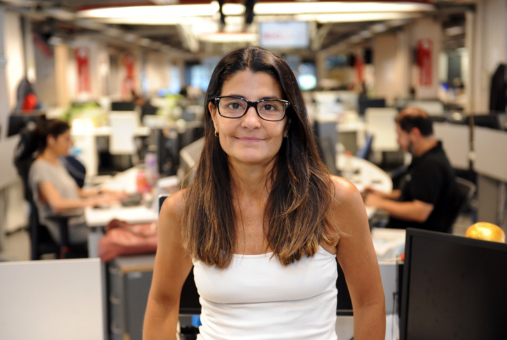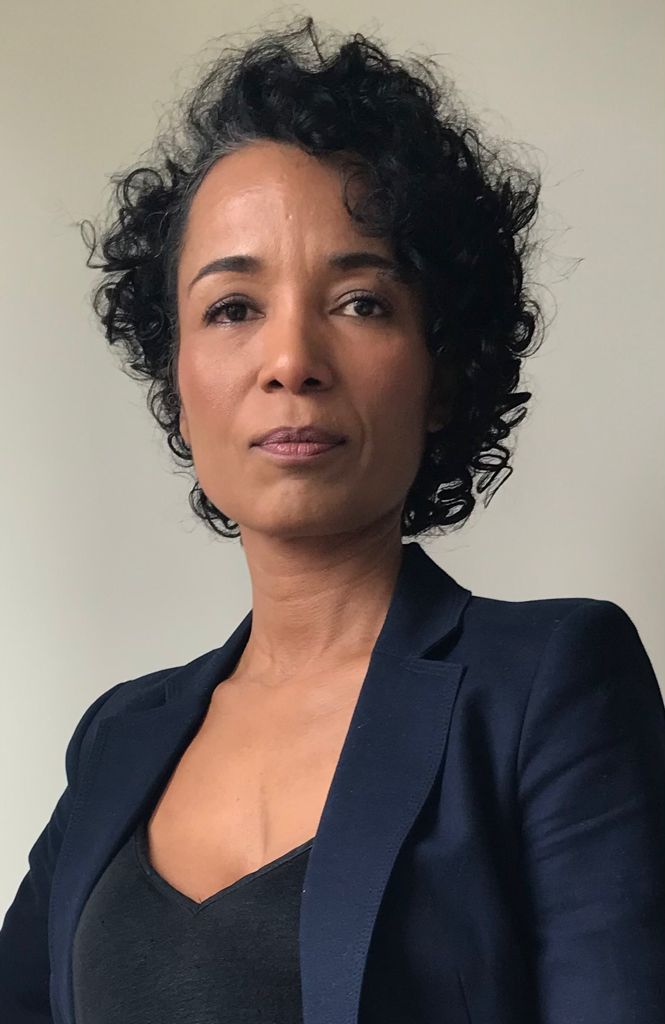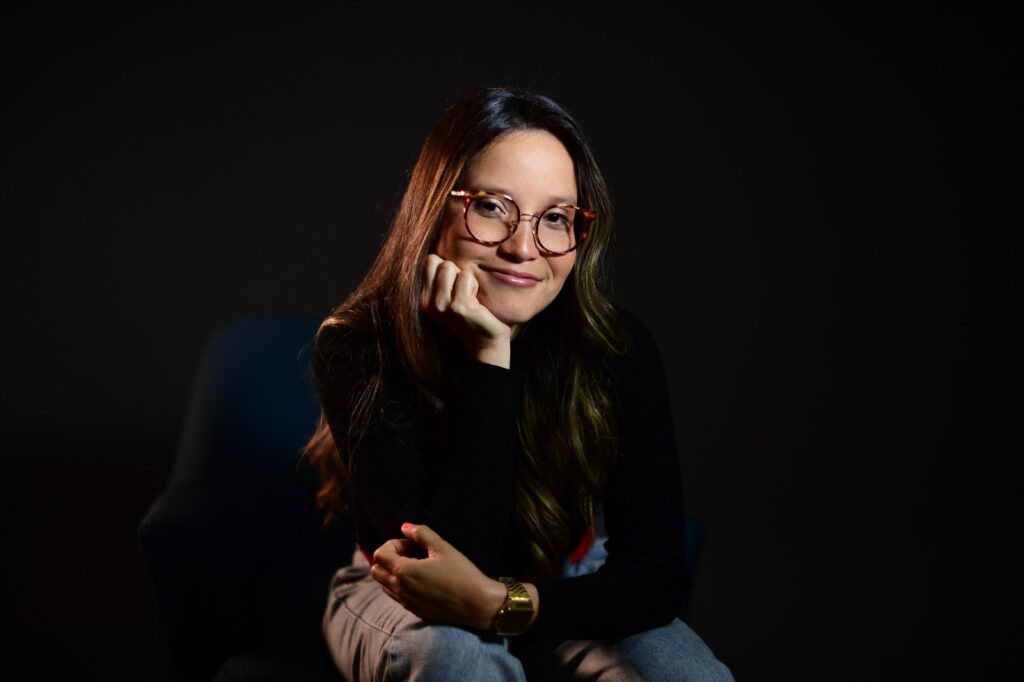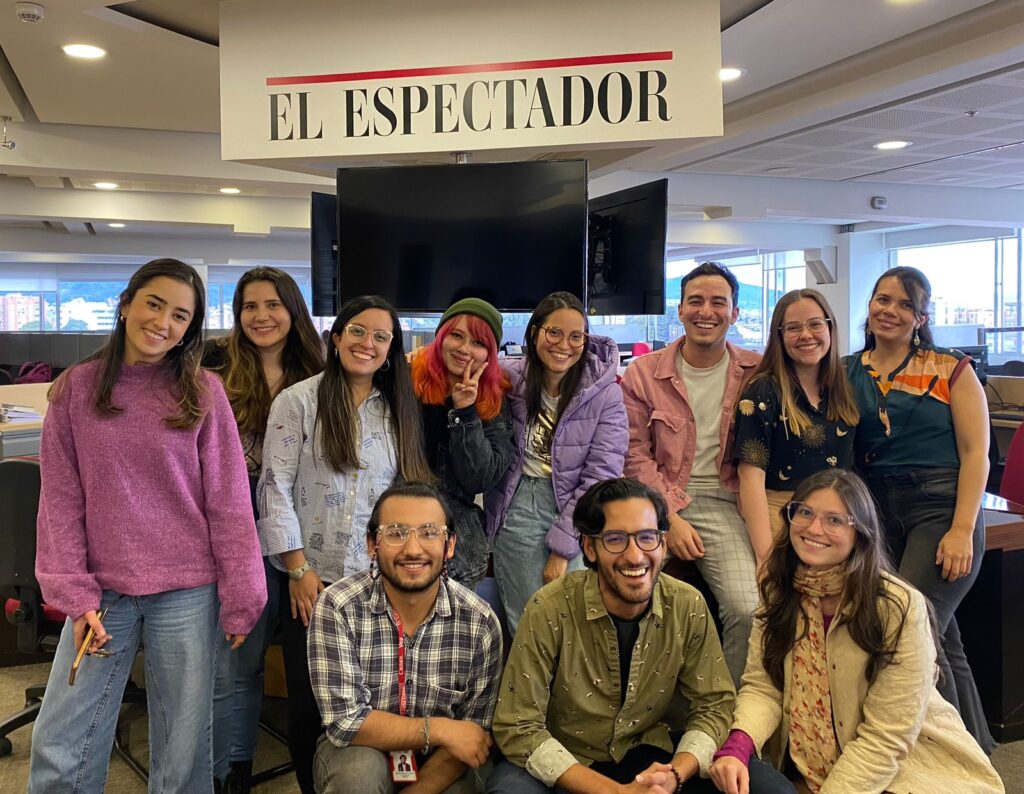Four years after the pioneering appointment of Mariana Iglesias at the Argentine newspaper Clarín, gender editors in the region have been promoting changes within newsrooms towards more attentive coverage of the rights of women, LGBTQ+ people and other marginalized groups. They too have faced unprecedented online violence and are working to consolidate their positions in the media where they work. To do so, they form alliances with colleagues in their newsrooms and with other editors in national and regional networks.
LatAm Journalism Review spoke with journalists, researchers and gender editors from four Latin American countries to understand the current status of these professionals in the region.
ALSO READ: Study shows 83 percent of gender editors in Argentina targeted by online violence

Argentinian journalist Mariana Iglesias, gender editor at newspaper Clarín. (Photo: Courtesy)
The position was active in mainstream news outlets in Argentina, Brazil, Chile, Colombia, Mexico and Peru. In El Salvador, Ecuador and Guatemala, at least one media outlet has had journalists in the position, but not at the moment.
In addition to being an achievement of women’s rights movements, the creation of the post of gender editor is a recognition by media of blind spots in their coverage and the need to adapt to new demands from the public. The idea is that these professionals take a gender and human rights approach to all coverage areas. They help colleagues to address stories in politics, economics, sports, health and other news areas from a gender perspective, with attention also paid to sources, images and language used in journalistic content.
To do so, gender editors say they need the collaboration and support of colleagues and management of their media outlet, and they often face resistance inside and outside the newsrooms. With frightening frequency, they become targets of digital violence: a first-of-its-kind survey found that 83 percent of gender editors in Argentina have been victims of targeted online attacks.
Mariana Iglesias, at Argentine newspaper Clarín, was the first journalist named gender editor in a mainstream media outlet in Latin America, on June 3, 2019. Four years later, she remains in the position, and today there are nine active gender editors in Argentina – the most fruitful country in the region for these professionals.
Iglesias has worked at Clarín since 1996, and has always done her reporting with a gender perspective, she told LJR.
“I asked for the position [of gender editor] in early 2018, when I found out that The New York Times had had a gender editor since late 2017. (...) I made an offer and they gave me the position a year later, on June 3, 2019. June 3 is a special date because, for us, it is #NiUnaMenos [Not one less], the day we march through the streets to demand an end to sexist violence,” she explained.
The list of goals set by Iglesias at Clarín illustrates the size of the responsibility of gender editors in mainstream media: “that all content has a gender perspective; that this perspective is transversal to all areas of the newspaper; that there are more women's voices in the stories, either as protagonists or as sources of information; that more stories of women, their progress and achievements are told, so that they are better represented in the media; and also to continue talking about their struggles, their demands, the gains that are still lacking, the rights that are not yet guaranteed; that communication is not sexist or discriminatory, that it respects all genders,” she explained.
In Brazil, a few weeks before Iglesias became gender editor at Clarín, newspaper Folha de S.Paulo created the position of diversity editor. Folha established that it should “reflect the variety of social life in Brazil,” and this variety includes not only gender, but also “ethnicity, social class, race, color, religious belief, disability, sexual orientation, age and political leanings,” the newspaper wrote at the time.

Brazilian journalist Flavia Lima, assistant managing-editor for diversity at Folha de S.Paulo. (Photo: Courtesy)
In May 2021, journalist Flavia Lima became Folha's diversity editor, and since February 2022 she has combined this position with that of assistant managing-editor for diversity. The latter was created to bring the gender approach to the leadership of the newspaper, she explained to LJR.
“My role is not just to produce content related to diversity. Our vision is to actually disconnect this content from this word 'diversity,' in the sense that it should be covered like any other relevant topic. So my role is less editorial and more institutional. In addition to working with editorial staff, we have a constant dialogue about what we are doing and how we can improve what we are doing,” Lima said.
In addition to exchanges with the editorial staff about coverage, Lima participates in Folha's hiring committees, to ensure that diversity is taken into account when hiring new employees at the newspaper. She also coordinates the newsroom's annual census, which measures diversity of gender, color/race and other social markers of interest among in-house journalists. She also leads Folha's training program aimed exclusively at Black professionals and she oversees the newspaper's projects to increase diversity among its sources and its audience.
So far, Folha is the only large mainstream media outlet in Brazil that has a position dedicated to mainstreaming the perspective of gender and diversity in coverage and in the institution.
For Lima, “it is in Folha's DNA to be attentive and to reflect the important changes that occur in Brazilian society.”
“Perhaps this does not happen with the speed that society wants, but it is certainly a newspaper that is ahead of the competition in this regard,” she said.
ALSO READ: Study shows 83 percent of gender editors in Argentina targeted by online violence
In Colombia, journalist and lawyer Pilar Cuartas also believes that newspaper El Espectador has a “progressive spirit” and has always provided coverage with a gender and human rights perspective. Ten years ago, when she joined the newspaper, this coverage was carried out autonomously by the publication’s reporters, Cuartas told LJR. El Espectador institutionalized this effort in July 2022, when she became the newspaper’s first gender and diversity coordinator.

Colombian journalist Pilar Cuartas, gender and diversity coordinator at El Espectador. (Photo: Courtesy)
Cuartas leads the team that produces the channels Las Igualadas, which creates videos on gender issues and women's rights, and La Disidencia, which focuses on sexual diversity. She also participates in general editorial meetings and helps colleagues address these issues in other sections of El Espectador. In addition, people from other sections can produce content for the gender and diversity section, and earn a bonus for doing so.
“There are journalists from all sections: judicial, sports, international, politics... That also allows me to have a little more influence in the newsroom, because I have allies in the sections. It has also allowed me to learn more about the newsroom, to integrate ourselves more with the rest of the newsroom and to not remain an island,” she said.
In addition to Cuartas at El Espectador, Colombia also counts on award-winning journalist Jineth Bedoya Lima as current gender editor at newspaper El Tiempo. She was appointed March 8, 2023.
Just as actions in favor of diversity, equity and inclusion in any area are rejected by some sectors of society, gender editors are not approved by all, and face resistance from some colleagues and members of the public.
According to Cuartas: “the first enemy of gender editors is the ego of other editors.”
She welcomes, therefore, that editors from other sections ask for her help in covering sensitive topics and in producing content that can benefit from the eye of a journalist with a gender perspective.
Both Cuartas and Lima noted that, at El Espectador and Folha, younger journalists tend to embrace the gender approach more than older journalists. A similar phenomenon occurs in audiences.

Journalists at El Espectador contribute to the gender and diversity section. (Photo: Courtesy Pilar Cuartas)
“Sometimes readers complain, especially the older reader,” Lima said about the response of some of Folha's audience members to the increase in coverage with a gender and diversity approach.
“He writes 'why is this important?', 'Folha is folding to identity-isms,’ 'I don't understand why I have to read this kind of thing'. These remarks normally come via the ombudsman, and I respond in a good way. To the last one, I said ‘I understand, maybe you are surprised, I don’t think they are identity stories, they are stories that should interest everyone.’ Then I sent several links with good articles that had been produced recently on these topics. It's an exchange, a learning experience,” she said.
ALSO READ: Study shows 83 percent of gender editors in Argentina targeted by online violence
Iglesias, at Clarín, said that “the same resistance that exists in society is experienced in a newsroom.”
“Everything improved [in coverage]. There are issues that are becoming more and more visible, reaching more people, in a clearer and simpler way. Of course there are reactions and resistance, but that is to be expected and it is a sign that shows that we are doing something right because it bothers those who do not want changes or advances or for societies to be more fair and equal.”
In order to strengthen themselves and face this resistance inside and outside the newsroom, gender editors and journalists who work with this perspective form networks and formal and informal alliances with colleagues from their countries and the region.
This year, Brazilian researcher Jessica Gustafson defended her doctoral thesis entitled “Journalists in alliance: weaving networks of protection and resistance in the formulation of a transnational gender perspective” at the Federal University of Santa Catarina (UFSC, for its acronym in Portuguese). According to her, these journalists share not only a gender perspective, but also a professional identity that unites them regardless of the media outlet where they work.
“We have an increase in discussions about gender, new reflections, and above all, a greater role [as journalists] within society. Journalism is both part of society and a reflection of society’s concerns, and it begins to reflect those concerns [about gender]. So we have a scenario of building rights and reacting to those rights. (...) There are two movements that go hand in hand: a demarcation of the journalism outlets themselves, which understand that these are valid demands and that we need to deal with these stories; and a series of attacks on the approach to these stories,” Gustafson told LJR about the current resistance and attacks against these professionals, which she classifies as an “anti-gender crusade” present across the region.
“The more journalists approach this perspective and bring it in a more positioned way, the more subject to violence they are. (...) They, in a way, also align themselves to build a protection network, because it is impossible to produce journalism on our terms when it puts us at risk of violence” she said.
ALSO READ: Study shows 83 percent of gender editors in Argentina targeted by online violence
In Argentina, the alliance between editors also involves engagement in feminist activism that won laws against gender violence and access to voluntary termination of pregnancy.
“In the 2018 debate on abortion, the number of young people who joined this 'green tide' was impressive. Luckily, many journalists and communicators also joined in the conquest of this long-awaited right, and we were left working in a network, collaboratively and horizontally. We are from diverse media with publics and audiences of all kinds and we work together because we know that it is the only way to reach all audiences. I think that made us strong and decisive in many issues,” Iglesias said.

Members of the Argentine Gender Editors Network (REG). (Photo: Clara Campos / UNFPA Argentina)
In November 2021, the Argentine Gender Editors Network (REG, for its acronym in Spanish) was created. It was formed from an initiative of the United Nations Population Fund (UNFPA) and currently brings together the nine gender editors active in the country. One of the objectives of the work of this UN agency in Argentina is the eradication of gender violence, and media are an arena to combat this type of violence, Mariana Isasi, head of the agency in the country, told LJR.
“There are a lot of issues related to imaginaries, stereotypes, among other issues that make gender violence possible. Communication is one of the strategies to begin to modify those cultural patterns that are so established in our society,” Isasi said.
The REG seeks to consolidate the positions of these professionals within newsrooms, establishing minimum performance parameters to “standardize without trying to limit the function,” Isasi said. It also supports editors when they are the target of violence, which has become increasingly common in the country and region.
“Editors are strongly harassed by anti-rights groups. We have been working on violence in digital environments and they are one of the main targets of violence on social networks. In some cases they have had to close network profiles because the harassment has been brutal,” she said. “We have also been saying that the virtual is real and has a direct impact on the lives of each person.”